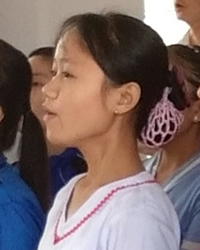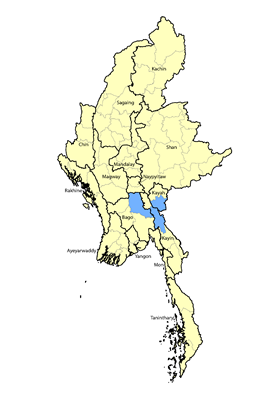Although they have always been considered part of the Karen race, the 1931 census of Burma separated the Paku Karen into two subgroups consisting of 8,122 Paku and 2,131 Monnepwa people. At the time, 80.3 percent of the people identified as Christians and the rest as animists.2 The early missionaries clearly viewed the Paku and Monnepwa as distinct groups.
Location: With a population of approximately 7,000 people, the Paku Karen tribe is spread over three states of eastern Myanmar. Most live in the Taungoo District of Bago Region, 170 miles (275 km) northeast of the nation's largest city, Yangon. Other Paku spill over into southern areas of Kayah State and into the rugged mountains of Hpapun in Kayin State, which borders Thailand and sits between the Yunzalin and Salween rivers.1 Over the years many Paku Karen families have been forced to live in Thai refugee camps because of the civil unrest in their homeland, but how many still reside in camps is unknown, as the Paku blend in with other displaced Karen people.
Language: There are at least seven recognizable Paku dialects today.3 Some are similar to S'gaw Karen, while others more closely resemble Bwe and Geba Karen. Most Paku Karen also speak S'gaw Karen or Burmese, and because their language has never had a written form, they have long used S'gaw Karen literature.
Taungoo District, where most Paku people live, has a long history. It was created by the Pagan Dynasty in the 1280s and was ruled by governors for centuries. Many Karen believe Taungoo is a key homeland for their race and that it was from there that the various tribes spread out across Myanmar and Thailand. In the 19th century, Taungoo consisted of 52 wards, but the district was cut in half during the Second Anglo-Burmese War in 1852-53. The British annexed the southern half, including the city of Taungoo, while the northern portion remained under Burmese control.
The clothing style appears to differ between the various Paku subgroups. Many men wear green, red, and white shirts, while women wear red skirts of various patterns. Paku Karen women hold a respected place in their communities. Their status may be partly due to the influence of the first missionary, Ellen Mason, who “worked to launch education for girls, which was a revolutionary idea to these Karen villagers. Although the plan was not favorable to the Karen chiefs in the beginning, she was later able to persuade them to accomplish her plan. More than 200 villagers came to cut wood and construct the buildings. The Karen Education Society took charge of the female institute, and the society ultimately included some 260 chiefs from six different tribes.”
For countless generations the forefathers of the Paku Karen were animists who worshipped a host of spirits presided over by shamans. Seismic changes in Paku Karen society occurred soon after American missionaries Francis and Ellen Mason first proclaimed the Gospel to them in October 1853.5 A strong response led to the founding of the Paku Karen Baptist Association in 1856.
After the initial conversion of Paku Karen to Christ, progress proved difficult. A 1907 report described the work in Taungoo as “one of repeated disappointments and reverses.”7 A breakthrough occurred in 1899, when revival resulted in hundreds of Paku families pressing into the kingdom of God. By 1931, more than 80 percent of Paku Karen people were Christians, and the church has continued to grow since then. Today, almost all Paku Karen confess Jesus Christ as Lord, with few vestiges of Buddhism or Animism remaining among them. For 170 years, the Paku Christians have used the S'gaw Karen Bible, and as a result, there is now probably no need for any specific resources in the Paku language.
Scripture Prayers for the Paku Karen in Myanmar (Burma).
| Profile Source: Asia Harvest |











